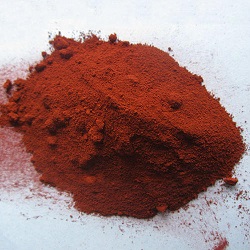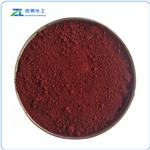Physical Properties
Reddish-brown hexagonal crystal; refractive index 2.91; density 5.25g/cm3; Moh’s hardness 6.0; melts at 1565°C; insoluble in water; dissolves in acids.

Occurrence and Uses
Ferric oxide occurs in nature as the mineral hematite. It is the principal ore of iron from which the metal and its alloys are produced. Also, this oxide occurs in the mineral, limonite, 2Fe2O3•3H2O. An important application of this compound involves producing red, orange, and yellow pigments. Other applications are in coatings for metals, steel and rubber; in ceramics; and as a catalyst for oxidation reactions.
Preparation
Ferric oxide is prepared as a reddish-brown hydrated precipitate by treating an aqueous solution of an iron(III) salt with caustic soda:
2FeCl3 + 6NaOH → Fe2O3•3H2O + 6NaCl
It also is obtained by thermal decomposition of iron(II) sulfate or the brown oxide hydroxide:
2FeSO4 → Fe2O3 + SO2 + SO3
2FeO(OH) → Fe2O3 + H2O
The oxide is prepared in industrial scale by first precipitating iron(II) hydroxide Fe(OH)2 by treating aqueous solutions of iron(II) sulfate and caustic soda. The Fe(OH)2 is then oxidized to iron(III) hydroxide by aeration. The latter is dehydrated by heating:
Fe2+ (aq) + OH¯ (aq) → Fe(OH)2(s) → 2Fe(OH)3 → Fe2O3 + 3H2O
It also is produced by ignition of iron(III) oxalate and iron carbonyls:
2Fe2(C2O4)3 +3O2 → 2Fe2O3 + 12CO
Reactions
Ferric oxide decomposes to its elements when heated at elevated temperatures:
2Fe2O3 → 4Fe + 3O2
The oxide is reduced by most reducing agents. Reaction with carbon monoxide at elevated temperatures (that occurs in the blast furnace) gives metallic iron. The overall reaction is mildly exothermic (ΔHrxn –113.4 kcal/mol):
2 Fe2O3 + 6CO → 4Fe + 6CO2
It also is reduced by powdered aluminum at elevated temperatures, forming aluminum oxide and metallic iron:
Fe2O3 + 2Al → Al2O3 + 2Fe
The reaction is highly exothermic and becomes self-sustaining after ignition.
When heated with sand in an electric furnace, iron(III) oxide forms ferrosilicon alloy. When heated in a vacuum at 1,000°C, it forms triiron tetroxide, Fe3O4.
Description
Iron oxides are produced synthetically and consist essentially of anhydrous and/or hydrated iron oxides. The range of hues includesyellows, reds, browns and blacks. Food quality iron oxides are primarily distinguished from technical grades by the comparatively low levels of contamination by other metals. This is achieved by the selection and control of the source of iron and/or by the extent of chemical purification during the manufacturing process. Iron oxides have been used to color confectionery, fillings and decorations for pastry products, cheese products, fish paste, pet foods, cosmetics and pharmaceutical products.
Chemical Properties
Hematite is a noncombustible, black to black red or brick-red mineral (iron ore) composed mainly of
ferric oxide, Fe2O3. Ferric oxide
Occurrence
Iron(III) oxide occurs in nature as the mineral hematite. It is the principal ore of iron from which the metal and its alloys are produced. Also, this oxide occurs in the mineral, limonite, 2Fe
2O
3?3H
2O. An important application of this compound involves producing red, orange, and yellow pigments. Other applications are in coatings for metals, steel and rubber; in ceramics; and as a catalyst for oxidation reactions.
Uses
Red iron oxide (Fe2O3) is an inorganic pigment of either
natural or synthetic origin. It is a low chroma red with excellent durability
and low cost. Synthetic pigment is made by heating iron sulfate
with quicklime in a furnace. The second preparatory technique involves
calcining iron sulfate in the presence of air at high temperatures.
Natural and oxides of iron are mined either as the mineral hematite
(Fe2O3) or as hematite in its hydrated form.
Uses
As pigment for rubber, paints, paper, linoleum, ceramics, glass; in paint for ironwork, ship hulls; as polishing agent for glass, precious metals, diamonds; in electrical resistors and semiconductors; in magnets, magnetic tapes; as catalyst; colloidal solutions as stain for polysaccharides.
Uses
Ferric Oxide is a nutrient and dietary supplement that is a source of
iron.
Definition
A high-grade red pigment used
as a polishing agent for glass, jewelry, etc. (2) A
cosmetic prepared from dried flowers of the saf-
flower.
Preparation
Iron(III) oxide is prepared as a reddish-brown hydrated precipitate by treating an aqueous solution of an iron(III) salt with caustic soda:
2FeCl
3 + 6NaOH → Fe
2O
3?3H
2O + 6NaCl
It also is obtained by thermal decomposition of iron(II) sulfate or the brown oxide hydroxide:
2FeSO
4 → Fe
2O
3 + SO
2 + SO
3 2FeO(OH) → Fe
2O
3 + H
2O
The oxide is prepared in industrial scale by first precipitating iron(II) hydroxide Fe(OH)2 by treating aqueous solutions of iron(II) sulfate and caustic soda. The Fe(OH)2 is then oxidized to iron(III) hydroxide by aeration. The latter is dehydrated by heating:
Fe
2+ (aq) + OHˉ (aq) → Fe(OH)
2(s) → 2Fe(OH)
3 → Fe
2O
3 + 3H
2O
It also is produced by ignition of iron(III) oxalate and iron carbonyls:
2Fe
2(C
2O
4)
3 +3O
2 → 2Fe
2O
3 + 12CO
.
Definition
A black solid prepared by passing
either steam or carbon dioxide over redhot
iron. It may also be prepared by passing
steam over heated iron(II) sulfide.
Triiron tetroxide occurs in nature as the
mineral magnetite. It is insoluble in water
but will dissolve in acids to give a mixture
of iron(II) and iron(III) salts in the ratio
1:2. Generally it is chemically unreactive; it
is, however, a fairly good conductor of
electricity.
Hazard
Pneumoconiosis. Questionable carcinogen.
Flammability and Explosibility
Non flammable
Potential Exposure
Hematite; as an iron ore composed
mainly of ferric oxide, is a major source of iron and is used
as a pigment for rubber, paints, paper, linoleum, ceramics,
dental restoratives; and as a polishing agent for glass and pre cious metals. It is also used in electrical resistors, semiconduc tors, magnets, and as a catalyst. Human exposure to hematite
from underground hematite mining is principally through
inhalation and/or ingestion of dusts. No estimates are available
concerning the number of underground miners exposed.
First aid
If this chemical gets into the eyes, remove anycontact lenses at once and irri gate immediately for at least15 min, occasionally lifting upper and lower lids. Seek med-ical attention immediately. If this chemical contacts theskin, remove contaminated clothing and wash immediatelywith soap and water. Seek medical attention immediately. Ifthis chemical has been inhaled, remove from exposure,begin rescue breathing (using universal precautions, includ-ing resuscitation mask) if breathing has stopped and CPR ifheart action has stopped. Transfer promptly to a medicalfacility. When this chemical has been swallowed, get medi-cal attention. Give large quantities of water and induce :vomiting. Do not make an unconscious person vomit.Note to physician: For severepoisoning,do not useBAL .[British Anti-Lewisite, dimercaprol, dithiopropanol (C3HgOS2)] as it is contraindicated or ineffective in poisoningfrom iron.
Carcinogenicity
Welders are typically exposed to a complex
mixture of dust and fume of metallic oxides, as
well as irritant gases, and are subject to mixeddust
pneumoconiosis with possible loss of pulmonary
function; this should not be confused
with benign pneumoconiosis caused by iron
oxide.1 Although an increased incidence of lung
cancer has been observed among hematite
miners exposed to iron oxide, presumably
owing to concomitant radon gas exposure,
there is no evidence that iron oxide alone is carcinogenic
to man or animals.6
storage
Color Code- Green: General storage may be used.Prior to working with this chemical you should be trainedonits proper handling and storage. Store in tightly closedcontainers in a cool, well-ventilatedarea. .Where possible,automatically transfer material from other storage contain-ers to process containers A regulated, marked area shouldbe established where this chemical is handled, used, orstored in compliance with OSHA Standard 1910.1045.
Properties and Applications
|
TEST ITEMS
|
SPECIFICATION
|
|
APPEARANCE
|
DARK RED POWDER
|
|
SHADE
|
CLOSE TO STANDARD
|
|
CONTENT OF
Fe
2
O
3
|
96% min
|
|
pH VALUE
|
3-7
|
|
OIL ABSORPTION
|
15-25%
|
|
RESIDUE ON 320 MESH
|
0.3% max
|
|
WATER SOLUBLE
|
0.3% max
|
|
VOLATITE 105 °C
|
1.0% max
|
|
TINTING STRENGTH
|
98-102 %
|
Incompatibilities
Contact with hydrogen peroxide, ethyl ene oxide, calcium hypochlorite will cause explosion.
Violent reaction with powdered aluminum; hydrazine,
hydrogen trisulfide.







